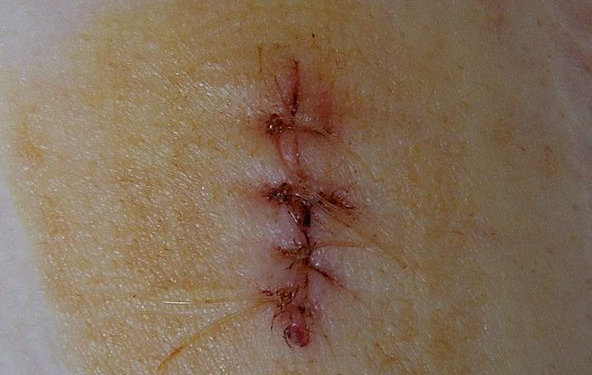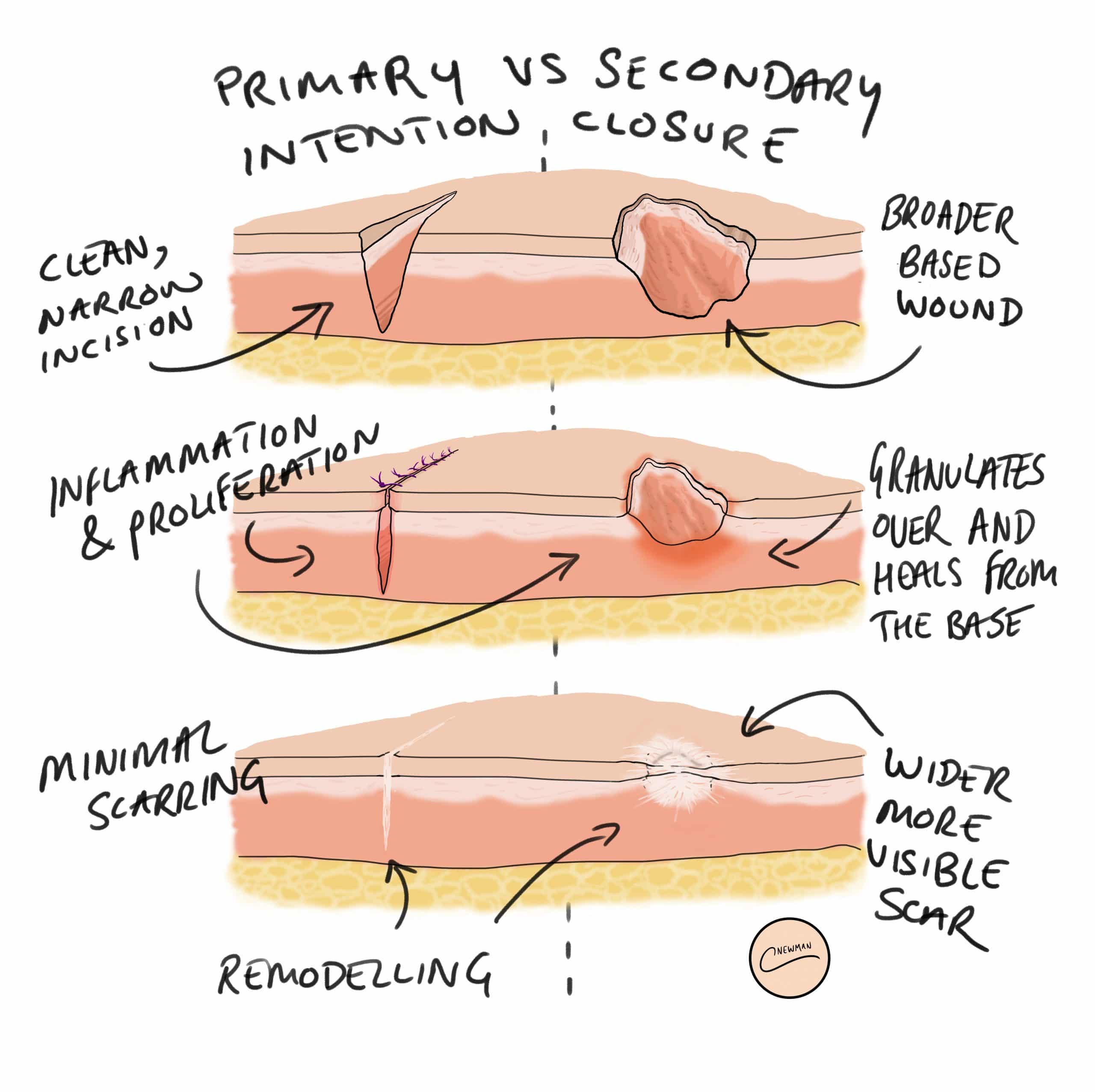Cutaneous wound healing is the process by which the skin repairs itself after damage. It is important in restoring normal function to the tissue.
There are two main types of healing, primary intention and secondary intention. In both types, there are four stages which occur; haemostasis, inflammation, proliferation, and remodelling.
In this article, we shall look the mechanisms of wound healing, factors affecting healing, and wound infection.
Primary Intention
Healing by primary intention occurs in wounds with dermal edges that are close together (e.g a scalpel incision). It is usually faster than by secondary intention, and occurs in four stages:
- Haemostasis – the action of platelets and cytokines forms a haematoma and causes vasoconstriction, limiting blood loss at the affected area
- The close proximity of the wound edges allows for ease of clot formation and prevents infection by forming a scab
- Inflammation – a cellular inflammatory response acts to remove any cell debris and pathogens present
- Proliferation – cytokines released by inflammatory cells drive the proliferation of the fibroblasts and the formation of granulation tissue
- Angiogenesis is promoted by the presence of growth mediators (e.g VEGF), allowing for further maturation of the granulation tissue; the production of collagen by fibroblasts allows for closure of the wound after around a week
- Remodelling – collagen fibres are deposited within the wound to provide strength in the region, with the fibroblasts subsequently undergoing apoptosis
The end result of healing by primary intention is (in most cases) a complete return to function, with minimal scarring and loss of skin appendages.

Figure 1 – A surgical wound, closed by sutures. This is an example of healing by primary intention.
Surgical Wound Healing
Any wound made by a scalpel will heal by primary intention. Surgeons can aid healing by ensuring adequate opposition of the wound edges, through use of surgical glue, sutures, or staples.
When sutures are used to close a wound, ensuring the correct tension of the sutures is essential:
- Too loose and the wound edges will not be properly opposed, limiting the primary intention healing and reducing wound strength
- Too tight and the blood supply to the region may become compromised and lead to tissue necrosis and wound breakdown
Secondary Intention
Healing by secondary intention occurs when the sides of the wound are not opposed, therefore healing must occur from the bottom of the wound upwards.
It occurs in the same four stages as primary intention:
- Haemostasis – a large fibrin mesh forms, which fills the wound
- Inflammation – an inflammatory response acts to remove any cell debris and pathogens present
- There is a larger amount of cell debris present, and the inflammatory reaction tends to be more intense than in primary intention
- Proliferation – granulation tissue forms at the bottom of the wound
- This is an important step, as the epithelia can only proliferate and regenerate once granulation tissue fills the wound to the level of the original epithelium; once the granulation tissue reaches this level, the epithelia can completely cover the wound
- Remodelling – the inflammatory response begins to resolve, and wound contraction can occur
Myofibroblasts are vital cells in secondary intention. They are modified smooth muscle cells that contain actin and myosin, and act to contract the wound; decreasing the space between the dermal edges. They also can deposit collagen for scar healing.
An uncommon complication from wound healing (particularly in people with darker skin), are keloid scars, whereby there is excessive collagen production, leading to extensive scarring. This can occur in both primary and secondary intention healing.
Factors Affecting Wound Healing
There are several factors that affect the success of any wound healing. They can be divided into local factors and systemic factors:
| Local Factors | Systemic Factors |
| Type, size, location of wound | Increasing age |
| Local blood supply | Co-morbidities, especially CV disease or DM |
| Infection | Nutritional deficiencies (especially Vitamin C) |
| Foreign material or contamination | Obesity |
| Radiation damage |
Table 1 – Risk Factors for Reduced Wound Healing
Contamination and Infection
Surgical site infections (SSI) occur when any infection gains entry to the body via a surgical environment. They represent around 15% of all healthcare-associated infections.
Wound contamination increases the risk of infection. It can be classified as per the US National Research Council guidance, which defines four classes of contamination, ranging from clean to dirty.
| Classification | Criteria description | Infection Rate |
| Clean |
|
2.1% |
| Clean-Contaminated |
|
3.3% |
| Contaminated |
|
6.4% |
| Dirty |
|
7.1% |
Table 2 – Classification of Wound Contamination, adapted from Berard et al
Key Points
- Cutaneous wound healing is the process by which the skin repairs itself after damage
- Healing by primary intention occurs in wounds with dermal edges that are close together
- Primary intention typically occurs in four stages: haemostasis, inflammation, proliferation, and remodelling
- Wound contamination increases the risk of surgical site infection, which can influence wound healing

